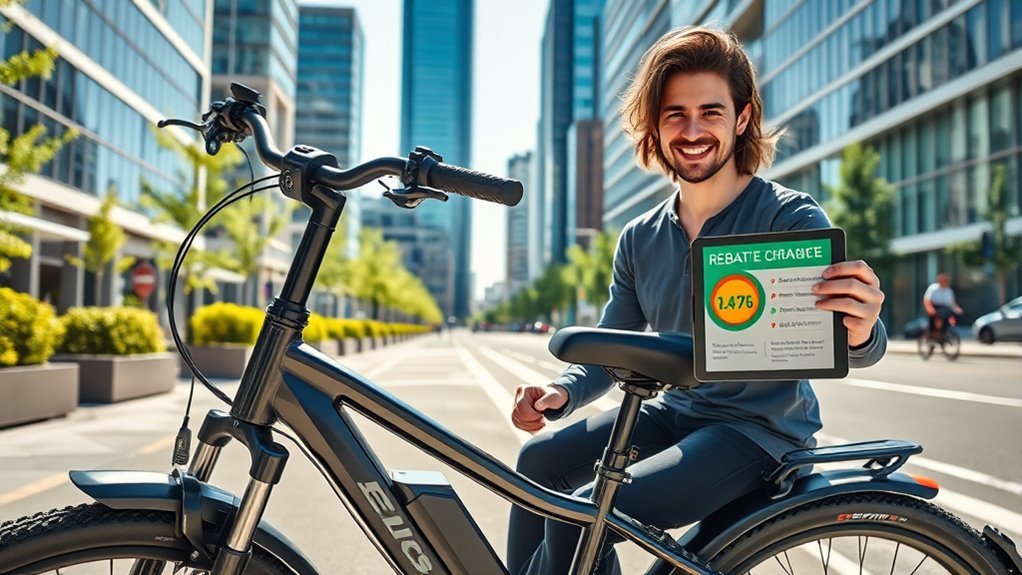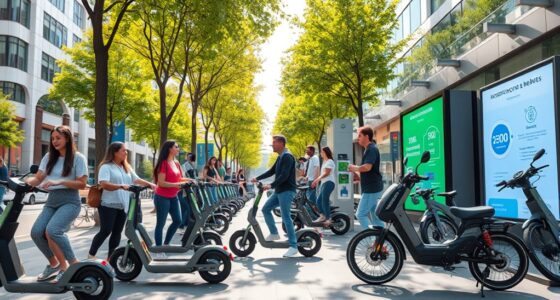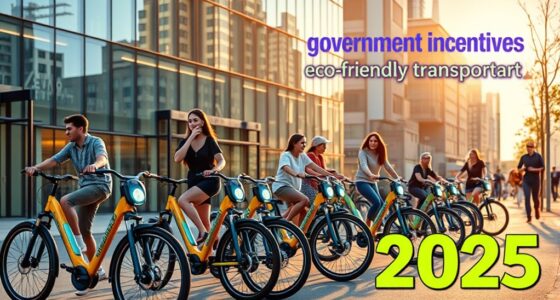In 2025, local incentives and rebates can help cut your e-bike costs considerably, making sustainable commuting more affordable. Many programs offer direct rebates covering a large portion of your purchase, especially for first-time buyers or low-income residents. Some locations also provide safety gear incentives or discounts on bike shares. These initiatives aim to boost eco-friendly transportation and reduce traffic. Keep exploring to discover how you can make the most of these opportunities.
Key Takeaways
- Many local governments offer rebates covering a significant portion of e-bike purchases in 2025.
- Incentives often require proof of purchase and may have residency or income restrictions.
- Programs promote safe e-biking through quality standards and safety gear incentives.
- Incentives support eco-friendly commuting by reducing traffic congestion and air pollution.
- Check local government websites for updated rebate details and application procedures in 2025.

Are you wondering how to make switching to an e-bike more affordable? If you’re considering an electric bike for your daily commute, local incentives and rebates can notably lower your upfront costs. E-bikes are becoming a popular choice for urban commuting, offering an eco-friendly and efficient way to navigate busy city streets. But the initial price can be a barrier, especially if you’re mindful of budgets. Thankfully, many cities and states have introduced programs to encourage sustainable transportation, making it easier to afford an e-bike and enjoy its benefits.
When you take advantage of local incentives, you not only save money but also promote bike safety by choosing a reliable, well-maintained e-bike. Properly funded programs often come with safety standards and quality requirements, ensuring you get a bike that’s safe for city riding. Urban commuting with an e-bike means you can dodge traffic jams, reduce your carbon footprint, and get some exercise, all while feeling secure on the road. Many incentive programs emphasize safety gear, such as helmets and lights, further encouraging responsible riding. This focus on bike safety aligns with the goal of making e-biking accessible and secure for everyone.
In many regions, rebates are offered directly through local governments or transportation agencies. These rebates can cover a substantial portion of the purchase price, sometimes up to hundreds of dollars. Some programs are targeted specifically at first-time buyers or low-income residents, ensuring that more people can access green transportation options. To qualify, you might need to provide proof of purchase or registration, and some programs have restrictions on the type of e-bike eligible. It’s worth checking your local government’s website or transportation authority for the latest details on available rebates and the application process.
Beyond rebates, some cities offer additional incentives such as discounted bike shares or free safety classes, making it easier to integrate e-biking into your daily routine. These programs often promote urban commuting as a practical alternative to driving, especially for short trips and daily errands. By taking advantage of these incentives, you not only save money but also contribute to reducing traffic congestion and air pollution. Plus, knowing you’re riding a bike that meets safety standards can give you peace of mind as you navigate busy streets. Additionally, understanding the importance of high-quality projectors can help you choose reliable equipment for your home entertainment needs.
Frequently Asked Questions
How Do I Qualify for Local E-Bike Incentives?
To qualify for local e-bike incentives, you usually need to purchase a compliant e-bike, ensuring it meets safety standards like proper E-bike safety features. Keep your battery well-maintained, as some programs require proof of regular maintenance. Check your city’s specific criteria, such as registration or residency, and submit any necessary documentation. Staying informed about local rules helps you maximize benefits while keeping your e-bike in top condition.
Are There Income Restrictions for Rebates?
Yes, income limits and rebate caps may apply to qualify for e-bike rebates. You might find that higher income levels disqualify you or reduce your rebate amount. Rebate caps set maximum limits on how much you can receive, regardless of the e-bike’s price. Check your local program’s specific rules, as income restrictions and caps vary by region and can change annually. Always review eligibility criteria before applying.
Can I Combine Multiple Incentives?
Yes, you can often combine multiple incentives through incentive stacking, but eligibility criteria vary. Check each program’s rules carefully, as some may limit the total amount you can receive or restrict stacking to certain rebate types. Make sure you meet all eligibility criteria for each incentive, including income limits or purchase conditions, to maximize your savings without disqualification. Always review local regulations for specific rules.
How Long Do Rebate Applications Take?
Think of your rebate application as an electric scooter zooming toward you—it usually takes a few weeks, often between 2 to 6, depending on your local program. During this time, your battery capacity and proof of purchase get verified. Stay patient and keep an eye out; once approved, the rebate will arrive faster than you’d expect, making your eco-friendly ride even sweeter.
Are There Specific E-Bike Models Eligible?
Yes, certain e-bike models meet the eligibility criteria for rebates. You should check the specific e-bike model requirements, which often include motor wattage limits and classification types. To guarantee your preferred e-bike qualifies, review the eligibility criteria outlined by your local program, as some models may be excluded if they don’t meet these standards. Always verify your chosen model against official guidelines before purchasing or applying for the rebate.
Conclusion
Imagine a future where your e-bike not only saves you money but also helps the environment. Local incentives and rebates make this dream achievable, turning eco-friendly commuting into an affordable reality. Some believe these programs can truly revolutionize urban transportation and reduce pollution. By taking advantage of these incentives, you’re not just saving money—you’re part of a movement toward cleaner, greener cities. Embrace the change today, and see how small steps create big impacts.









